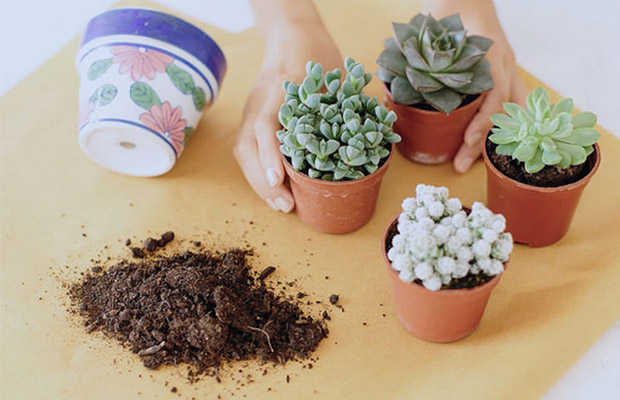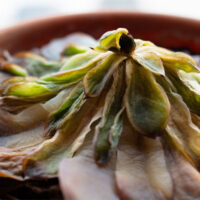You can add hardy succulents to an indoor or outdoor space. The proper method for repotting succulents, we are frequently questioned. Although it’s very simple to repot a succulent, there are certain procedures you must follow to protect the stability and health of your plant.
How to repot succulents? To stabilize the plant, create a shallow hole in the new soil, place your succulent in it, and then gently cover the roots with more potting soil. Make sure to add enough so that it reaches the plant’s base, but avoid covering any leaves or letting them rest on top of the soil!
Continue reading if you want to learn more about how to grow succulents so they can fill out your indoor garden.
Table of Contents
When To Repot Succulents & Why?
Repotting your succulents is necessary for a number of reasons. However, it’s always best to do it just before their growing season, which typically occurs in the early spring or early fall for most succulents, regardless of the reason. The succulents will have ample time to recover from the repotting in this way.
Signs to help you determine the right time when to repot:
- Newly purchased succulents. Succulents that have just been purchased typically come in tiny, plastic containers, which may stunt their growth. Therefore, it is strongly advised that you move your new plant to a different planter within two weeks of bringing it home (preferably one that will help with moisture and has proper drainage, like a terracotta pot).
- Outgrowing its pot, the succulent now protrudes. When this happens, you’ll usually see that the roots begin to stick out of the potholes as the space is getting too tight, preventing them from growing to their full potential.
- The soil dries out too quickly after watering, requiring you to water the plant more often or if you see that the water doesn’t soak through the drainage hole of the pot, risking your succulent to develop root rot. Read More: How Much Water Do Succulents Need?
- The plant begins to appear ill or unhealthy. Although succulents are given the right amount of light and water, their once-plush and lush leaves may suddenly become soft, shriveled, or yellowing. When this occurs, check your succulents right away for any possible pest infestations, root rot, or other diseases. Remove the plant from the pot and inspect the roots if there are no indications of a problem on the leaves. A clean pot with new soil should be used after removing any that are already dead or don’t appear to be in good health. Read More: Do Succulents Need A Lot Of Light?
- The succulent starts to sag or falls over. This is not necessarily a sign that a succulent needs to be moved to a larger pot once you notice it on one of your plants. They typically do this to let you know that even though the roots of your succulent are still content in the pot they are in, the top has grown heavy and needs to be repotted into a pot with more weight to prevent it from toppling over.
- have grown offsets or young. Many succulents will produce offsets, or what we commonly refer to as pups. When your succulents have given birth to a few pups, it’s time to repot, separate them from the mother plant, and begin propagating.
Read More: How to Replant Succulents?
Best Soil For Repotting Succulents
For the healthiest succulent plants, a porous sandy potting mix is best because succulents prefer dry soils with good drainage. If you don’t have a sandy soil mixture, you can also use potting soil or cactus soil with pumice or perlite to help with drainage. Due to an accumulation of too much water, root rot can occur in clay soils or regular potting soils that do not drain well.
Read More: What Type of Potting Soil Do Succulents Need?

How To Repot Succulents?
There are a number of reasons you might think about moving your succulents, including the fact that their current containers are too small, which makes it difficult for their root systems to expand. Repotting your succulents also gives the plant a fresh soil mix that is nutrient-dense and aerated.
- Gather supplies. When you have the right equipment, repotting is simple. You’ll require fresh soil that drains well and a pot with a hole in the bottom. Choose a bigger pot than you currently have: The plant’s new home should be at least 10% bigger than your succulent. Succulent plants grow best in terra cotta planters because they absorb excess moisture, but any container with a drainage hole will work. A small, handheld gardening shovel is useful when repotting your succulents but is not required.
- Prepare the new pot. Scoop out the potting soil with your hands or a gardening shovel, and then add soil to the new pot until it is about three-quarters full. To keep it from sticking to the pot’s sides, mix and aerate the fresh soil before placing it inside.
- Remove the plant from its old pot. Shake and tap the plant gently out of the old pot as you turn the pot on its side and gently loosen the soil with your hands or a small gardening shovel. If your succulent has developed offshoots, carefully pry the new succulents away from the mother plant so they can grow in different pots.
- Inspect the roots. You might want to take a closer look at the roots before repotting your succulent if your plant has experienced root rot. Brush off as much of the potentially contaminated soil from the roots as you can, and use garden shears or scissors to trim off any black or brown roots.
- Transfer the plant to a new pot. In the pot that has been prepared, put the succulent. Make sure the succulent roots are completely covered in potting soil and the succulent leaves are entirely above the soil line by adding more potting soil to the pot. Water your succulent sparingly, letting any extra liquid drain out the bottom of the pot.
Caution & Warning
- It’s critical to keep in mind that if your succulent begins to bloom, you should never repot it. Repotting could halt the flowering cycle and cause the succulent’s flower to fall off.
- Don’t overwater: When repotting, take care not to water the plant too soon after putting it in the new pot or soak it in water for too long. If your succulent receives too much water during this process, it will develop root rot.
When In Dormancy, Should You Repot Your Succulent?
The period during which a plant is still alive but not actively growing is known as dormancy, so the answer is no. Repotting them at risk could mess up your succulents’ growth cycle and even be harmful. Since most succulents go dormant in the summer or the winter, spring and fall are ideal times to do a little repotting. Repotting winter-dormant succulents in the spring will give them time to adjust to the new pot and soil before growth season while repotting summer-dormant succulents in the fall.
To make sure the soil is new and fertile and that the plant has enough room to grow, you should repot your succulents on average every two years. Furthermore, you should pay attention to timing. Repotting should be done during the plant’s active growing period, which is typically spring or summer, to minimize plant damage and increase the likelihood of the plant surviving.
Read Next: Propagating Succulents In Water

















